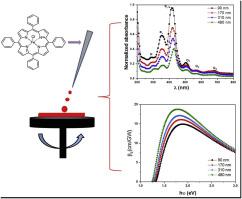Thickness-dependent linear and nonlinear optical properties of spin-coated iron (III) tetraphenylporphyrin chloride thin films
IF 4.2
3区 材料科学
Q2 MATERIALS SCIENCE, MULTIDISCIPLINARY
引用次数: 0
Abstract
This study investigated the thickness-dependent structural, linear, and nonlinear optical properties of spin-coated iron (III) tetraphenylporphyrin chloride (FeTPPCl) thin films. Thin films with thicknesses ranging from 90 to 480 nm were fabricated on quartz substrate via spin coating method, and then characterized using X-ray diffraction (XRD), scanning electron microscope (SEM), Raman spectroscopy, UV–Vis–NIR spectroscopy, and photoluminescence (PL) spectroscopy. The results revealed that film thickness significantly influenced crystallinity, surface morphology, and optical behavior. Thicker films exhibited significantly increased crystallite size (from 23.09 to 50.18 nm), enhanced crystallinity, and reduced structural defects, as evidenced by XRD analyses and SEM images. UV–Vis spectroscopy showed a redshift in absorption peaks and a systematic reduction in the optical bandgap with increasing thickness. Urbach energy (EU) analysis indicated a decrease in disorder and localized states in thicker thin films, corroborating improved structural order. Photoluminescence (PL) studies revealed a thickness-dependent emission redshift and intensity increase, attributed to enhanced crystallinity and reduced surface traps. The absorbance coefficient (α) was employed to identify the nature of optical transitions in the films. The optical constants and dielectric properties exhibited notable thickness-dependent trends, consistent with the Wemple-DiDomenico and Sellmeier models. Furthermore, nonlinear optical properties, including third-order susceptibility , nonlinear refractive index and two-photon absorption coefficient (βc), were modulated by film thickness, highlighting FeTPPCl's potential for nonlinear optical applications. These findings underscore the critical role of thickness control in tailoring the optoelectronic performance of solution-processed FeTPPCl thin films for advanced device applications.

自旋包覆四苯基卟啉铁(III)薄膜的线性和非线性光学性质
本研究研究了自旋涂覆四苯基卟啉铁(feppcl)薄膜的厚度依赖性结构、线性和非线性光学性质。采用自旋镀膜法在石英衬底上制备了厚度为90 ~ 480 nm的薄膜,并用x射线衍射(XRD)、扫描电镜(SEM)、拉曼光谱、紫外-可见-近红外光谱和光致发光(PL)光谱对其进行了表征。结果表明,薄膜厚度对结晶度、表面形貌和光学性能有显著影响。XRD分析和SEM图像显示,较厚的薄膜晶体尺寸明显增大(从23.09 nm增加到50.18 nm),结晶度增强,结构缺陷减少。紫外可见光谱显示,随着厚度的增加,吸收峰红移和光学带隙系统地减小。Urbach能量(EU)分析表明,较厚薄膜的无序和局域态减少,证实了结构有序的改善。光致发光(PL)研究表明,由于结晶度增强和表面陷阱减少,发射红移和强度增加与厚度有关。利用吸光度系数(α)来表征薄膜的光学跃迁性质。光学常数和介电性质表现出明显的厚度依赖趋势,与Wemple-DiDomenico和Sellmeier模型一致。此外,非线性光学性质,包括三阶磁化率(χ(3))、非线性折射率(n2)和双光子吸收系数(βc),都被薄膜厚度调制,突出了feppcl在非线性光学应用中的潜力。这些发现强调了厚度控制在定制先进器件应用的溶液处理feppcl薄膜的光电性能方面的关键作用。
本文章由计算机程序翻译,如有差异,请以英文原文为准。
求助全文
约1分钟内获得全文
求助全文
来源期刊

Optical Materials
工程技术-材料科学:综合
CiteScore
6.60
自引率
12.80%
发文量
1265
审稿时长
38 days
期刊介绍:
Optical Materials has an open access mirror journal Optical Materials: X, sharing the same aims and scope, editorial team, submission system and rigorous peer review.
The purpose of Optical Materials is to provide a means of communication and technology transfer between researchers who are interested in materials for potential device applications. The journal publishes original papers and review articles on the design, synthesis, characterisation and applications of optical materials.
OPTICAL MATERIALS focuses on:
• Optical Properties of Material Systems;
• The Materials Aspects of Optical Phenomena;
• The Materials Aspects of Devices and Applications.
Authors can submit separate research elements describing their data to Data in Brief and methods to Methods X.
 求助内容:
求助内容: 应助结果提醒方式:
应助结果提醒方式:


